🩺 Care and Management
New Born Calf, Heifers, Pregnant, Lactating Animal, Bull
Which of the following statment is correct?
Care of the New-Born calf

- Remove the mucus from the nose and mouth and clean it.
- If the calf does not start breathing, artificial respiration should be used by pressing and relaxing alternatively, the chest walls with hands. Another method is to hold the calf by the rear legs and lift from the floor with the head down. This may be repeated several times and helps in restoring respiration.
- As soon as the calf starts breathing, observe as to whether the navel cord is still attached. The navel cord should be disinfected. The navel cord of the calf is tied about 2.5 cm away from the body and cut about one centimetre below the ligature. Apply
tincture of iodineto the cut end and repeat it 2-3 days. This will prevent infection.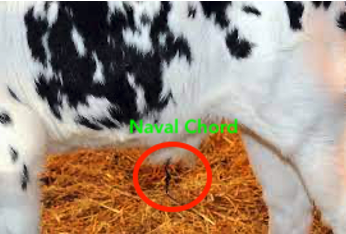
- Then, if the cow does not lick the calf dry, or if the weather is cold, the herdsman should wipe the calf to clean and dry.
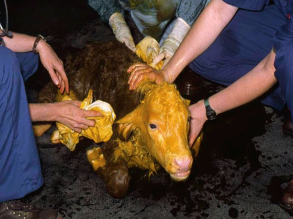
Colostrum Feeding

- The next important step to follow is to feed the Colostrum within 15 minutes of calving, the calf should be fed with colostrum at the rate of
1/10th of body weight and buffalo calves at the rate of1/15th of body weight. - Colostrum containing low fat,
high protein, vitamins and minerals forms a balanced feed for new-born calves. This helps to protect the calf against various diseases as it contains antibodies. - Colostrum also helps to eliminate the material accumulated in the digestive tract before it was born.
- Colostrum prevents against Calf scour, Night Blindness and Navel ill.
- Colostrum in secretion of mammary glands during the first
3-5 daysafter calving. - Fat in buffalo colostrum is
4 %.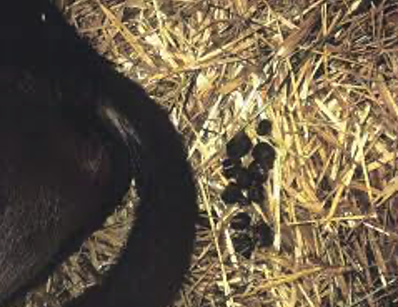
- If
muconiumis not voided out, mild enema by dissolving soap in a liter of warm water should be given. - Muconium is the first faecal matter or stool of newborn.
Identification
- Identification of animals is must, as a requirement in the daily management, to spot and identify a particular animal in a herd/group/flock.
- This is essential for good management, especially in breeding farms.
Methods of Identification
- Ear Tagging: It is the most popular method of identification system. Because tags can be read without catching the animal, easy-to-use, all-weather-type, easy-to-read and inexpensive.

- Ear tattooing: Permanent identification is by tattooing the inside of the ear with indelible ink.

- Branding: It is one of the permanent method of identification.

- Ear Notching: Commonly used in pigs and in beef cattle.
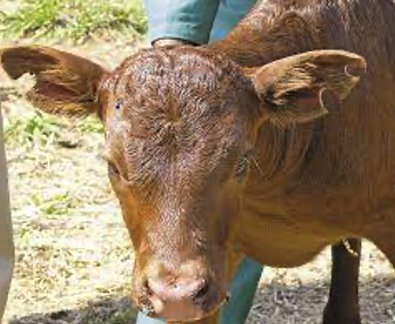
- Metal ear tags or button with letters and numbers may be inserted in the ear as a means of identification.

- Neck strap or neck-chain with a number plate attached, make an easy method of identification.
Body weight
- Body weight of the calf is recorded on a balance along with length, breadth and height for the computation of milk allowance.
- Well-fed cross bred calves on an average should gain
400 gramsa day or 2.5 to 3 kilograms per week.
System of Calf rearing
-
If possible follow weaning at birth & care should be taken to see that adequate colostrum is fed for the first 3-4 days.
-
The calf is allowed to stay with its mother & to suckle only a little before & after the cow are milked.
-
The calf is taken away from its mother after the colostrum period. After that, feeding & management of the calf will be entirely in the hands of the dairyman. This is called the
Weaning system. -
Weaning: Separation of calf from the mother after parturition is known as weaning.
-
Individual pen is best for first few weeks.
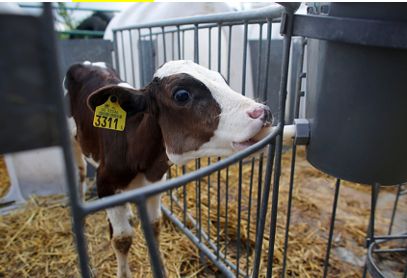
-
After 8 weeks of age, it may be handled with a group.
-
Separate male and female calf after
6 months. -
Advantages of Weaning
- If the calf accidently dies, there is no difficulty in regular milking of the cow.
- By following a weaning system the calves can be fed economically & just as much as may be necessary for them.
- In this way the calf can be saved from some diseases like diarrhoea etc, which are results of uncontrolled feeding.
- The actual yield of milk of the cow - the essential item of dairy farming - can be entered in the milk record.
- Total yield increases - if the owner wants milk in
quantityhe must practice “weaning system”. - Milking without a calf is more hygienic & sanitary. (Major advantage)
Feeding Management
- Utensils should be clean -if not- severe digestive upsets.
- Either the nipple pail or the open type buckets are satisfactory for feeding milk or milk replacer.

- It may take less effort to teach a calf to nurse from a nipple pail than to drink from an open pail. Also, a rapid consumption of milk from an open pail may at times cause digestive upsets.
- To teach a calf to drink from an open pail, place your fingers in its mouth and after it starts to nurse lower its head into a pail of warm milk or milk replacer. It may be necessary to repeat the process several times. A stubborn calf may need to be backed into a corner and restricted by standing aside its neck.
- Milk temp: 98 – 102°F - if cold milk - cause calves to shiver and chill.
- At any case, calves should not be overfed. The stomach of the calf needs time to develop fully and become able to digest plants.
- At first can only digest milk and a 2 month old calf will drink 4 to 6 litters of milk daily.
- At 2 week age, milk is reduced & calf starter is rubbed to mouth after each feeding for few days when the calf will be accustomed to it.
- Feed calf starter
after 2 weeks(From 3rd week onwards). It is high in protein. It is a mixture of ground farm grains, protein feeds & minerals, vitamins & antibiotics. - Feed silage @ 1-2 kg daily to calves at the aged up to 3 to 4 months & then increase these amount 500 gm per day for each month of the calf age.
- Six months, calves can be given the same type of concentrate mixture (70% Total Digestible Nutrient (TDN) and 14 – 16 % Digestible Crude Protein (DCP) as used for adult cattle).
- Removal of supernumerary teats:
- A maximum of normal
4. At 1 month old. - Clip it off with a pair of sterilised scissors.
- Removal of supernumerary teats is also important and this has to be carried out before development begins.
- A maximum of normal
Disbudding
- Disbudding means arresting the horn growth at an early age, when the horn root is in the bud stage.
- Both the buds are destroyed at the early age (within
3 to 10 days). - Dehorning or disbudding is the process by which the horns of an animal are removed after birth by treating the tender horn roots with a chemical (Caustic Soda), mechanical or electrical dehorner.
- Dehorning of yearlings & older animals is painful & results in considerable bleeding.
- The practice is, therefore, to dehorn the calf before 10 days old. Up to this age the horn button does not become attached to skull.
- Purpose:
- Dehorned animals will need less space in the sheds.
- Cattle with horns inflict bruises on each other that may result in heavy economic losses.
- Horned animals are a danger to the operator.
- Dehorned animals can be handled more easily.
- Prevents the occurrence of horn cancer.
- Disadvantages:
- Animals with a nice horn have a style. This sometimes is an advantage in exhibition & cattle shows.
- Some breeds have got an important identification marks for horn. Kankrej, Murrah buffalo etc.
- Animals with horn can defend themselves.
- Methods
- Hot iron method: This is bloodless method it may be used at any season. For this a specially designed electric dehorner is used for this purpose. Rod with 500 degree Celcius temperature applied for 10 seconds.

- Elastrator: A specially made thick rubber ring applied to the base of the horn. Small buds drop off in 3 to 6 weeks and large horns may take even 2 months.

- Chemical method: Caustic potash or caustic soda is the common chemical used for dehorning. Rub the chemical over the buds until bleeding occurs.

- Hot iron method: This is bloodless method it may be used at any season. For this a specially designed electric dehorner is used for this purpose. Rod with 500 degree Celcius temperature applied for 10 seconds.
Dehorning

- When older cattle are to be dehorned a specially designed clippers or dehorningsaw are used.
Deworming
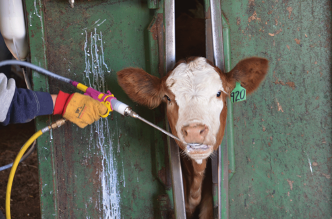
- Deworming should be started from the first week of calf.
- Initially calf immunity is less, so deworm the calf at 30 days interval.
- For prevention of Ascaris in calves.
Piperazine saltis administered.- Deticking: Removal of the external parasites like ticks, lice, mites present on the body surface of animal.
Disease Management
- Protected from white scours, common scours, pneumonia, ringworm & internal parasitic attack.
Bull Calf
- Castration is the unsexing of the male or female & consists in the removal of either testicles or ovaries respectively.
- Its objectives are to prevent reproduction, to increase faster gains, to produce a desirable type of meat & to make the animal docile & easier to handle.
- The best time is
8-10 weeksfor calves. - Casting: It is throwing down the animal and securing the limbs for various purposes like surgical operations, castration, hoof trimming, shearing etc.
- Methods:
- Operation or Surgical method:: AKA
Orchidectomy. Scrotum is opened and testicles as removed, aseptically and the wound is treated with antiseptic. - Burdizzo’s castrator: It is also known as bloodless castration. The Burdizzo castrator is used to crush the spermatic cord separately an inch or two above the testicle. Therefore this stops the blood to the testes.
- Rubber ring: Used in western countries. They use strong & tight rubber ring around the cords at an early age of calf.Elastrator ring very painful to the animal and so it is not usually recommend. Optimum age is below 3 months.
- Operation or Surgical method:: AKA
Nasal septumin bull calves be punctured for pulling a rope or nose ring at the age of 12 months.
Care & Management of Heifers
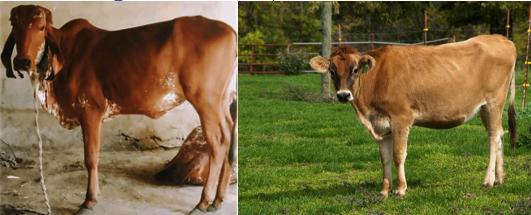
- Heifers are reared indoors or outdoors.
- Outdoors - protection from the adverse climatic condition, rain, hot sun, snow, heavy winds biting flies, parasitic infestation.
- Exotic breeds - Heifers performance is slow in tropical areas in the outdoors.
- Small breeds - Age at first breeding - 15 months, Larger breeds - 18 months.
- Adequate live weight would be 200-225 kg for smaller breeds and 275 kgs for the larger breeds.
- Cross bred heifers show signs of heat as early as 10 months of age but none of them are mated until attain the body weight of 225/275 body weight or a minimum of 14 months age.
- Age at first calving 25-30 months.
- Feeding of Heifers: Maintenance Ration
- Follow proper Vaccination Schedule.
- Housing:
-
- Outdoor system / Grazing method
- Rotational grazing.
- Arrangement of shade and drinking water – pasture land
- Care to be taken not to overstock on limited grazing land.
- Concentrate feed is to be provided – Centrally located feed trough.
- Protect from rain.
-
- Indoors
- Management in covered area.
- Sufficient concentrate feed and fodder provided.
- Steaming up of heifers
- Feeding grains to pregnant heifers prior calving at 1.5 Kg per day. It helps in their growth, bear the stress of foetus. It produces more milk after calving and increases lactation length.
-
- Training of heifers: Heifers in early stage should be lead with halter to make them docile.
- Pregnant Heifers are to be housed along with milking cows at least a month prior to calving.
- The udder should be washed warm water and mopped with cloth to accustom her to feel the hands in this place. Just few days prior to calving pulling teats slightly may be practiced so that heifer would not excited.
- Control of Parasites – Dewormed periodically: 4 – 6 months intervals
- Grooming:
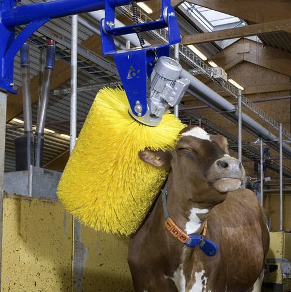
- Grooming refers to the process of cleaning animals so that their coats are free of dust, dirt, manure and sweat.
- Grooming is to be practiced to avoid ecto-parasites.
Care & Management of Pregnant animals
- Minimum 45 – 60 days of dry period is essential. Identify pregnant-after A.I. - 90 days. Gestation period is 282 days. Knowing expected date of calving is must for taking all future care.
- Provide gentle treatment to advanced pregnant cows, care should be taken to prevent:
- Being injured by slipping in stable floor.
- Long distance travel.
- Chasing by dogs, bulls or children.
- Fighting between pregnant animals.
- Separate pregnant animals from recently aborted animals or carriers of diseases like brucellosis.
- Provide concentrate feed 3.5 kg per day. Provide 25 – 35 Kg Green fodder per day and 5 Kg Paddy straws. Provide calcium by bone meal in diet to prevent milk fever.
- Watch for parturition signs: Swelling of the udder, swelling of the vulva & dropping away ligaments around the tail head. At this stage she should be housed in calving pen.
- The majority of domesticated animals require little or no assistance in the actual act of parturition, provided they are in a reasonably healthy & vigorous state. At the same time, it is advisable that someone shall be at hand to give any help if some emergency arises.
- The placenta will normally leave the cow within 4-6 hours. If it is not expelled between 8-12 hours, administer
Ergot mixture. Beyond 12 hours, apply manual help by a veterinarian. When placenta expelled, prevent cow from eating & dispose-off by burying in ground. - After parturition the exterior of the genitalia & tail should be washed with warm clean water containing some crystals of KMnO4.
- Keep cow warm to prevent her from chill & it is desirable to give her warm water or warm gur sarbat to drink just after parturition.
- There are always danger that high producing cows will develop milk fever & mastitis. The dairyman should remain alert for any symptoms of diseases. To avoid milk fever, it is best not to draw all the milk from the udder for a day or two after calving. To avoid mastitis, regular tests should be made by a veterinarian.
- Feed the cow at first only bran mash moistened with molasses to provide laxative.
- After 2 days a mixture of oats, bran & linseed mash can be used to replace the barn mash.
Care and Management: Lactating animals
- Protection against inclement weather.
- Housing – 3.5 m2 (covered) or 7 m2 (open).
- Hygiene and sanitation of cattle shed and animals grooming, washing, disinfection etc.
- After parturition when first milking, ensure that all blockages from teats removed.
- Cow may be milked 3 time a day until the inflammation disappears.
- Feeding: Provide Production ration
- Thumb Rule:
450 – 500 gConcentrate / Kg milk production - DCP & TDN of ration must be 16-18 % & 70 % respectively.
- Provide enough minerals, 40-60 gm sterilized bone meal & 40 gm common salt may be added to grains. With 1 to 2 % mineral in the ration.
- Green fodder: 1:3 ratio of leguminous and non-leguminous fodder.
- Green fodder is harvested at 50% flowering.
- Thumb Rule:
- Peak yield –
6 week– ‘Ca’ deficiency. - Breeding –
60 days aftercalving does not come to heat – check with veterinary Doctor. - Artificial Insemination – Pregnancy verification – 90 days
- Periodical vaccination.
Care of Bull
- Feeding of Bull

- Shoeing – road work – once in a month. If used for Field work – once in two months.
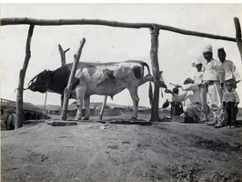
Insurance
- Always have a insurance for your animals.
- Generally the insurance premium is
5% of animal cost.
References
- G.C. Banerjee: A Textbook of Animal Husbandry
- https://www.dairyknowledge.in
- https://buffalopedianew.cirb.res.in/godavari/
- https://nbagr.icar.gov.in/
- https://www.nddb.coop/
- Wikipedia
Which of the following statment is correct?
Care of the New-Born calf

- Remove the mucus from the nose and mouth and clean it.
- If the calf does not start breathing, artificial respiration should be used by pressing and relaxing alternatively, the chest walls with hands. Another method is to hold the calf by the rear legs and lift from the floor with the head down. This may be repeated several times and helps in restoring respiration.
- As soon as the calf starts breathing, observe as to whether the navel cord is still attached. The navel cord should be disinfected. The navel cord of the calf is tied about 2.5 cm away from the body and cut about one centimetre below the ligature. Apply
tincture of iodineto the cut end and repeat it 2-3 days. This will prevent infection.
- Then, if the …
Become Successful With AgriDots
Learn the essential skills for getting a seat in the Exam with
🦄 You are a pro member!
Only use this page if purchasing a gift or enterprise account
Plan
- Unlimited access to PRO courses
- Quizzes with hand-picked meme prizes
- Invite to private Discord chat
- Free Sticker emailed
Lifetime
- All PRO-tier benefits
- Single payment, lifetime access
- 4,200 bonus xp points
- Next Level
T-shirt shipped worldwide

Yo! You just found a 20% discount using 👉 EASTEREGG

High-quality fitted cotton shirt produced by Next Level Apparel